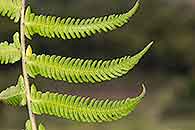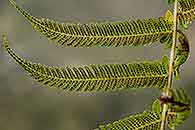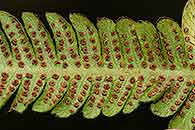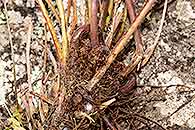Christella gueinziana (Mett.) Holttum
Synonyms |
Thelypteris gueinziana (Mett.) Schelpe |
|---|---|
Common name |
|
Description |
Rhizome erect, c. 20 mm in diameter; rhizome scales broadly lanceolate to ovate in outline, apex pointed, margin entire, up to 4 mm long, brown. Fronds monomorphic, tufted, arching, not proliferous, herbaceous to subcoriaceous. Stipe 30-50 cm long, pale brown, thinly set with minute white hairs and with brown scales near the base. Lamina 2-pinnatifid, ovate-lanceolate in outline, basal pinnae gradually reduced and deflexed but not forming a series of much-reduced pinnae down the stipe, up to 1.2 × 0.45 m but average half this size; pinnae narrowly oblong in outline, apex long tapering to a point, pinnatifid; ultimate lobes narrowly oblong in outline, slightly falcate, apex pointed to sharply rounded, 4-12 x 2-3.5 mm, both surfaces thinly set with hairs, more so along the costae and costules; veins 1 pair meeting in the sinus between the lobes; rhachis pale brown, thinly pilose. Sori round, up to 16 per lobe; indusia 0.7 mm in diameter, subcircular to kidney-shaped with slender white hairs or sometimes almost hairless. |
Notes | Christella guenziana closely resembles C. chaseana but the latter has a creeping rhizome.
|
Derivation | gueinziana: named after Wilhelm Gueinzius (1814-1874), German apothecary and naturalist in KwaZulu-Natal, South Africa |
Habitat | Shaded or exposed stream- and riverbanks in open grassland and forest. |
Distribution worldwide | Africa, Madagascar, possibly St. Helena. |
Distribution in Africa |
Angola, Burundi, Dem. Republic of Congo, Ethiopia, Kenya, Malawi, Mozambique, Rwanda, South Africa, Sudan and South Sudan, Swaziland, Tanzania , Zambia, Zimbabwe. |
Growth form |
Lithophytic, terrestrial. |
Literature |
|







